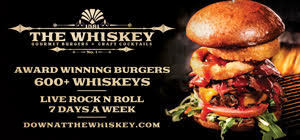So then there’s the review in the New York Times by Pete Wells of Guy’s American Kitchen & Bar. (If you just said, “Huh, what are you talking about?” congratulations on waking up from your coma.) Wells’ review, published Wednesday and linked to here, is still today the most-viewed and most-e-mailed article at NYTimes.com. It has been the topic of news and talk show interviews, including rebuttals from the restaurant’s owner and food television personality, Guy Fieri.
As reviews go, they don’t get much more negative than this one. It was written almost entirely of rhetorical questions addressed to Fieri and worded to register high on the snark meter. Sample: “Why is one of the few things on your menu that can be eaten without fear or regret — a lunch-only sandwich of chopped soy-glazed pork with coleslaw and cucumbers — called a Roasted Pork Bahn Mi, when it resembles that item about as much as you resemble Emily Dickinson?” Or “Hey, did you try that blue drink, the one that glows like nuclear waste? The watermelon margarita? Any idea why it tastes like some combination of radiator fluid and formaldehyde?”
Readers love this sort of scathing, take-no-prisoners review. They read them with a sense of schadenfraude, glad to see someone being taken to task in a highly public fashion for doing an inferior job, and being able to relate because they’ve had similarly poor experiences.
As someone who has written a fair share of negative reviews, I can tell you that, for the most part, they are not fun to write. Each time I write one I agonize over the possible ramifications. Real people will be affected by the words; some people will lose their jobs, others will lose a lot of money.
But sometimes they must be written. Sometimes things go so horribly wrong that a negative review is the only possible outcome and there is no agonizing over it. More than a few times I’ve said to my dining companion during a dinner-from-hell experience, “I love it when the reviews write themselves.”
Why not just walk away from restaurants like that? I have, at times. Especially when the restaurant is a low profile one, an obscure business that does not need the help of a professional reviewer to reach its inexorable extinction.
But high-profile restaurants are a different thing. If a restaurant is actively trying to attract customers, give them lousy food and service, and take their money, well, those are fair game. And if they’re owned by a corporation or celebrity, all the better.
That seems to be the rationale for Wells’ review of the Fieri fiasco. Here was a 500-seat restaurant in the Times Square district, the New York equivalent of Orlando’s International Drive.
(How’s this for irony: Guy’s American Kitchen & Bar occupies the space that was formerly the headquarters of the New York Times. And more coincidence: on the day the review was published, the Times’ ad department held a party for 150 people — at Guy’s. Talk about awkward!)
One might ask why Wells even wasted his time and considerable expense account (six figures) on such a place. Because it’s there. Because if even half of what Wells wrote is true, no one should get away with that. I can’t speak for other critics, but my rationale for ultimately publishing negative reviews that would affect the people involved is that the people who would be wasting their money — the unsuspecting guests — had a right to a professional assessment.
Wells directed almost all his ire at Fieri. The staff was only collaterally damaged. In the information box that accompanied the review, the box where the rating was listed as poor with zero stars, the notation on service says “The well-meaning staff seems to realize that this is not a real restaurant.” I wonder if any of them took solace in that. When I reviewed a new restaurant on New York’s east side last year that was opened by celebrity chef Tom Collichio, I mentioned the inferior service in my negative review, noting that fine service–and food to go with it–are the mainstay of Collichio’s other restaurants. I was reminded of the individual people involved with a restaurant when I received multiple mailings from the hapless young server’s mother. (Seriously, lady, let it go.)
Ultimately, I think Wells had a ball writing this review. I think it was cathartic to get it out of his system and address a personality with such impersonal detachment. It’s possible that the review will have little effect on the restaurant’s business. Likely, even. Few readers of the Times’ dining reviews had Guy’s on their to-eat-at list. Those 500 seats will be filled with the tired backsides of tourists thrilled at the prospect of eating in a celebrity’s restaurant, situated in one of the world’s most recognizable locations, a place that glows brighter than Fieri’s bleached hair.










